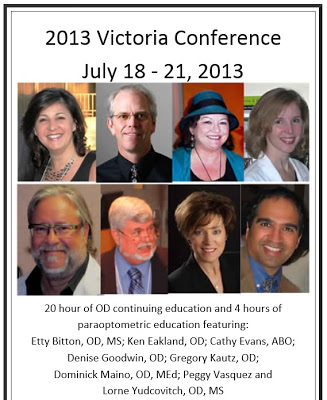Investigating Gaze of Children with Autism Spectrum Disorder (ASD) in Naturalistic Settings
...Ten children with ASD and ten typically developing children participated in a dyadic interaction with an experimenter administering items from the Early Social Communication Scale (ESCS). ..... The analysis of gaze episodes to faces revealed that children with ASD looked significantly less and for shorter lapses of time at the experimenter. .....
Comments: Read full text by clicking the title above. DM
MainosMemos contains the latest research and information about eye and vision care of children, developmental disabilities, Traumatic/Acquired Brain Injury and other topics of interest to me (and hopefully you!).
Saturday, April 13, 2013
Friday, April 12, 2013
Overcoming Reading Problems: How Can We Stlil Raed Words Wehn Teh Lettres Are Jmbuled Up?
Overcoming Reading Problems: How Can We Stlil Raed Words Wehn Teh Lettres Are Jmbuled Up?
......Researchers in the UK have taken an important step towards understanding how the human brain 'decodes' letters on a page to read a word. The work, funded by the Economic and Social Research Council (ESRC), will help psychologists unravel the subtle thinking mechanisms involved in reading, and could provide solutions for helping people who find it difficult to read, for example in conditions such as dyslexia. .....
Comments: Would it hurt 'em to mention the fact that binocular vision problems can impact reading and just maybe the letters of words are jumbled up because of these funtional anomalies? DM
Thursday, April 11, 2013
Prevalence of Parent-reported Autism
Prevalence of Parent-reported Autism
.....The CDC now estimates that in 2011-2012, about 1 in 50 school-aged children, or 2 percent of children ages 6-17 years have some form of the disorder. Since the average school bus holds 50-55 children, that means, statistically speaking, on average there is one child with parent-reported ASD on every school bus in America.......
.....The CDC now estimates that in 2011-2012, about 1 in 50 school-aged children, or 2 percent of children ages 6-17 years have some form of the disorder. Since the average school bus holds 50-55 children, that means, statistically speaking, on average there is one child with parent-reported ASD on every school bus in America.......
Wednesday, April 10, 2013
Tuesday, April 9, 2013
Atypical Brain Circuits May Cause Slower Gaze Shifting in Infants Who Later Develop Autism
Atypical Brain Circuits May Cause Slower Gaze Shifting in Infants Who Later Develop Autism
....Infants at 7 months of age who go on to develop autism are slower to reorient their gaze and attention from one object to another when compared to 7-month-olds who do not develop autism, and this behavioral pattern is in part explained by atypical brain circuits.....
....Infants at 7 months of age who go on to develop autism are slower to reorient their gaze and attention from one object to another when compared to 7-month-olds who do not develop autism, and this behavioral pattern is in part explained by atypical brain circuits.....
Monday, April 8, 2013
Air Force Study Confirms Efficacy of Vision Training
Air Force Study Confirms Efficacy of Vision Therapy
.....According to Major Janelle Robertson, a doctor and statistician in the
96th Medical Group who compiled and analyzed the data, the results were
dramatic. "The Airmen who were trained on Battlevision improved their
scores by 65 percent, while the scores of their non-trained counterparts
dropped by 69 percent," said Robertson. "There is such a large
difference in the performance of these groups that they could not have
arisen statistically by chance.".....
Comments: Yes, optometric vision therapy works not only for those with vision problems, but enhances the capabilities of all....even those in our armed forces. This article offers other articles on improving your vision capabilities as well. DM
To BV or Not to BV: Vision Therapy in the Primary Care Office
To BV or Not to BV:
Vision Therapy in the Primary Care Office
Over the last few years I've noticed a trend among my students, recent Illinois College of Optometry graduates and even colleagues that have been out of optometry school for several years. My students and optometric colleagues have been contacting me about how to set up an optometric vision therapy program within their office.
If you want to know how to offer this tremendous service within your practice, please come to the Victoria Conference July 18-21st sponsored by the Pacific University College of Optometry.
Click here for the brochure. Click here to register for the meeting.
Vision Therapy in the Primary Care Office
Over the last few years I've noticed a trend among my students, recent Illinois College of Optometry graduates and even colleagues that have been out of optometry school for several years. My students and optometric colleagues have been contacting me about how to set up an optometric vision therapy program within their office.
If you want to know how to offer this tremendous service within your practice, please come to the Victoria Conference July 18-21st sponsored by the Pacific University College of Optometry.
Click here for the brochure. Click here to register for the meeting.
Sunday, April 7, 2013
The Optokinetic Uncover Test: A New Insight Into Infantile Esotropia
Uncover Test: A New Insight Into Infantile Esotropia
....All patients showed poor temporally directed optokinetic responses that instantaneously improved when the occluded esodeviated eye was uncovered, exposing it to nasally directed optokinetic motion. ......this suggests that monocular nasotemporal optokinetic asymmetry is partly attributable to subcortical visuovestibular responses mediated by nonfoveal retina.....
....All patients showed poor temporally directed optokinetic responses that instantaneously improved when the occluded esodeviated eye was uncovered, exposing it to nasally directed optokinetic motion. ......this suggests that monocular nasotemporal optokinetic asymmetry is partly attributable to subcortical visuovestibular responses mediated by nonfoveal retina.....
Subscribe to:
Posts (Atom)

